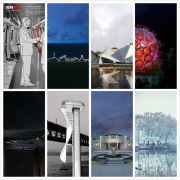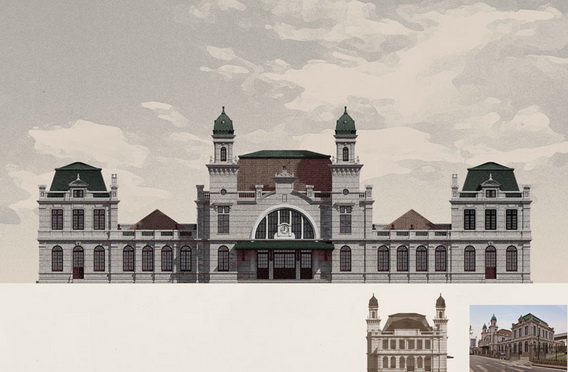魏因加特(Wolfgang Weingart)的文字设计中国巡展即将揭幕
来源: 陆俊毅_设计现场 发布时间:2017-09-26 14:43
|
导言: 由中央美术学院美术馆、同济大学设计创意学院、广州国家广告产业园和广州美术学院主办的“魏因加特的文字设计”中国巡展将于9月15日在北京中央美术学院美术馆揭开首展序幕,展览将持续至2017年10月8日并于今年10月至12月巡展至上海和广州。活跃于1960和70年代的瑞士平面设计师与设计教育家沃夫冈·魏因加特(Wolfgang Weingart)在瑞士国际主义风格的基础上,打破了媒介与技术中的限制和常规,在设计过程中创造性地运用铅活字排印、底片拼贴等媒介与手段开创了全新的平面设计语言,他通过设计教学与实践影响了从世界各国慕名而来的年轻设计师,其中来自美国的设计师将被称为“新浪潮”的文字设计从瑞士巴塞尔带到了北美。这股浪潮与彼时在美国兴起的后现代主义相呼应,对当代平面设计产生了极为深远的影响。本次展览得到了苏黎世设计博物馆(Museum für Gestaltung Zurich)的大力支持。苏黎世设计博物馆藏回顾总结了魏因加特几十年以来的所有作品,通过这次展览在中国大陆第一次也是最完整地介绍魏因加特的设计作品。超过200件由魏因加特捐赠的设计作品、过程手稿及其学生作品将在本次巡展中展出。
沃夫冈·魏因加特(Wolfgang Weingart)
瑞士平面设计师与设计教育家沃夫冈·魏因加特(Wolfgang Weingart)生于二战时期的德国,年轻时期在斯图加特接受了专业的字体排印训练,之后赴瑞士巴塞尔设计学院(Schule für Gestaltung Basel)深造。1960年代中期,魏因加特开始了他的实验文字设计与抽象图形构成,并受到瑞士国际主义设计代表人物时任平面设计系主任的阿敏·霍夫曼(Armin Hofmann)的注意。尽管魏因加特的设计作品和当时正处于鼎盛时期的瑞士国际主义风格迥异,霍夫曼仍充分感受到其中蕴含的能量,1968年霍夫曼邀请魏因加特在学院任教。随后的几十年间,魏因加特通过设计教学与实践影响了一批又一批从世界各国闻名而来的年轻设计师。其中以 Dan Friedman 和 April Greiman 等为代表的美国设计师将被称为“新浪潮”的文字设计从瑞士巴塞尔带到了北美,而这股浪潮与彼时在美国兴起的后现代主义相呼应,对平面设计产生了更为深远的影响。
被称为“顽童”(enfant terrible)的魏因加特因其反叛精神为人所知,他善于打破媒介与技术中的限制和常规,创作的手段和媒介跨越了手工和机械铅活字排版、多重底片拼贴、复印机、凸版印刷与平版胶印等,甚至还尝试性地使用了数字化设计工具。他突破了铅活字排版中水平和直角方式构成的天然限制,大胆地改造字母与词语间距,通过使用多种字号形成强烈对比,灵活运用铅字素材和自创的材料改变整体的构成方式。1970年代,魏因加特将半色调底片结合拼贴手法,利用照排技术设计出具有丰富层次和独特质感的海报印刷作品。魏因加特种种超前的设计手法和理念,尽管发生于数字化设计浪潮来临之前,但却教科书般地向后辈设计师们预示了一种新的平面设计语言的可能。
魏因加特长期从事研究性的平面设计工作,坚持不懈地致力于平面设计作为一种视觉语言的深化。这种深化的设计语言所蕴含和发散出的能量对现当代平面设计产生了超越时代和媒介的影响。魏因加特“背叛”的瑞士国际主义设计风格尽管继续影响着世界并被不断地发展,但是他激发的“新浪潮”以及其后汇入的后现代主义设计思潮,却以另一种方式大大增加了现代平面设计的广度与深度。
魏因加特的活跃时期早在中国对外开放、当代平面设计作为一门专业技能和知识萌发之前,对于大多数中国设计师而言或许还有一些陌生。当下中国的平面设计语言和视觉文化正在快速发展、媒介和技术以惊人的速度迭代变迁,而文字设计的重要地位近年来在中国设计界和设计教育中也在被不断地强调。在这样一种中国语境里“重温”魏因加特的文字设计,是为了把一种超越时代与媒介的重要设计传统和思潮化入本土设计的文脉。我们希望这个展览与越来越多这样的引介可以为现代中国平面设计的发展、视觉语言的丰富贡献经验和参考,为中国设计师在媒介和技术的深刻理解基础上形成深厚的现代设计观和方法论,提供依据和基础。
主办:中央美术学院美术馆、同济大学设计创意学院、广州国家广告产业园与广州美术学院
承办(广州):广州美术学院视觉艺术设计学院、广东现代广告创意中心发展有限公司
协办:瑞士苏黎世设计博物馆、瑞士苏黎世艺术大学 Connecting Space Hong Kong、香港知专设计学院及香港专业教育学院(李惠利)
支持: 北京国际设计周、中央美术学院设计学院、瑞士驻上海领事馆、同济设计周、广州美术学院美术馆
赞助:瑞士联邦政府科技文化中心、康戴里中国、上海艾登印刷有限公司、北京飞行鱼文化发展有限公司艺术微喷工作室、广州广物房地产开发有限公司
媒体合作:DESIGN360、陆俊毅_设计现场、Type is Beautiful、最毕设
艺术总监:张子康(北京站)/娄永琪(上海站)/曹雪(广州站)
学术顾问:王敏
策展人:吴帆(北京站)/杜钦(上海站)/万千个(广州站)
▼Wolfgang Weingart 作品

Wolfgang Weingart, Das Kotzenbuch, double page, 1970–1972, letterpress, manual typesetting © ZHdK

Wolfgang Weingart, Typographische Monatsblätter Nr. 11/1970, double page, 1970, letterpress © ZHdK

Wolfgang Weingart, M, photo optical experiment, 1965, photo collage © ZHdK

Wolfgang Weingart, Kunstgewerbemuseum Zürich – Schreibkunst, exhibition poster, 1981, offset (photo collage) © ZHdK

Wolfgang Weingart, Q, design alternatives for the cover of the magazine Design Quarterly, 1995, Xe-rography © ZHdK

Wolfgang Weingart, Was ich morgen am liebsten machen würde, typographic text interpretation, 1965, letterpress, manual type setting © ZHdK

Wolfgang Weingart, Das Kotzenbuch, double page, 1970–1972, letterpress, manual typesetting © ZHdK

Wolfgang Weingart, Experiment Buch, double page, 1962, wood print © ZHdK

Wolfgang Weingart, Typographische Monatsblätter Nr. 11/1973, magazine cover from his series of 8, 1973, letterpress © ZHdK

Wolfgang Weingart, Kunstkredit 1978/79. Mustermesse Basel, exhibition poster, 1979, offset (photo collage) © ZHdK

Wolfgang Weingart, The 20th Century Poster, exhibition poster, 1984. Courtesy of Museum für Gestaltung Zürich © ZHdK
Introduction:
September 15, 2017 – Weingart Typography China Touring Exhibition, organised by Art Museum of Central Academy of Fine Arts (Beijing), Tongji University College of Design and Innovation (Shanghai), Guangzhou National Advertising Industrial Park and Guangzhou Academy of Fine Arts (Guangzhou), is to first open in Beijing on September 15, 2017 at the Art Museum of Central Academy of Fine Arts. The exhibition will be touring to Shanghai and Guangzhou from October to December to Tongji University and Guangzhou Academy of Fine Arts. Swiss graphic designer and design educator Wolfgang Weingart is known for his pioneering work in typography and graphic design in the 1960s and 70s. He rebelled against the then dominant Swiss International Style and spoke with an eloquent typographic voice of his own. Through teaching and practice Weingart influenced generations of students from all over the world and inspired a “New Wave” of typography which traveled from Basel to North America. This wave reverberated with the emerging Post-modernism in the country to create an impact on graphic design in profound ways. Weingart Typography China Touring Exhibition presents the first comprehensive exhibition in China devoted to the work and teaching of Wolfgang Weingart and is based on the exhibition by Museum für Gestaltung Zürich in 2014. All of the exhibits come from the Museum’s own collections and are donated by Mr. Weingart, including more than 200 pieces by Weingart himself as well as examples of his students’ work.
Body:
Born in Germany during WWII, Swiss graphic designer and design educator Wolfgang Weingart was formally trained as a typographic apprentice in Stuttgart. He then went on to study in Schule für Gestaltung Basel. In the mid-1960s, Weingart embarked on his typographic experiments and abstract graphic compositions, which got into the attention of the eminent “International Typographic Style” representative and Dean of graphic design Armin Hofmann. Although Weingart’s design was in many ways divergent from the then prevalent “Swiss Style”, Hofmann still sensed its potential energy. In 1968 Hofmann invited Weingart to teach at the school. In the next decades, Weingart would influence through teaching and practice generations of young designers who were attracted to the Basel school by its reputation. Later, American designers, among them Dan Friedman and April Greiman, were to bring what’s called the “New Wave” typography from Basel to North America. This wave reverberated with the then emerging Post-modernism in the country to impact on graphic design in profound ways.
Often described as an “enfant terrible”, Weingart was known by many for his revolutionary character. He is good at breaking the rules and restrictions imposed by medium and technology. His choice of mediums and techniques encompass manual and mechanical lead typesetting, lithographic film collage, xeroxing, letterpress and offset printing, and even an investigative use of digital design tools. He broke the rules of typesetting including the dogma of the right angle, spacing out letters and words and creating stark typographic contrasts with the use of multiple type sizes at once. His flexible use of type and inventive choice of materials resulted in a distinctive visual quality in his (typo-)graphic composition. In the 1970s Weingart used collaged layers of halftone film in his composition to create posters with a rich and unique visual texture. Weingart’s pioneering design methods and concepts, though preceding the arrival of digital design tools, foretold possibilities of a new typographic style to future generations of designers almost like a textbook.
Weingart has devoted a lifetime to the research and practice of graphic design, continuously expanding its visual language. The energies released from this expanded language exerts an influence on modern and contemporary graphic design that transcends medium and time. The Swiss International Typographic Style that Weingart rebelled against continues its course of development and influence the world today in newer mediums and context. Nevertheless, the “New Wave” inspired by Weingart later echoed by the post-modernist movement in graphic design has undoubtedly expanded the width and depth of modern graphic design.
Weingart’s active period precedes the opening up of China, before contemporary graphic design emerged as an area of expertise in China, therefore he might seem a little distant to most Chinese designers. But as the visual vocabulary and culture of Chinese graphic design rapidly expand with the explosion and alternation of media and technology, typography is once again brought to the agenda by Chinese designers and design educators. To “revisit” Weingart’s typography in China today is an attempt to introduce a crucial design tradition and thinking that transcends time and medium into our own context. We hope that this exhibition, together with many more such to come, will contribute to the development of modern Chinese graphic design and the enrichment of its visual lexicon, and provide grounds and references for more and more Chinese designers to form their own design methodology by rigorously investigating contemporary medium and technology.
Hosts: Art Museum of Central Academy of Fine Arts, Tongji University College of Design and Innovation, Guangzhou National Advertising Industrial Park and Guangzhou Academy of Fine Arts
Organizers(Guangzhou): School of Visual Arts Design, Guangzhou Academy of Fine Arts,Guangdong Modern Advertising Creative Center Development co., LTD
Co-organizers: Museum für Gestaltung Zürich, Zurich University of the Arts, Hong Kong Design Institute and Hong Kong Institute of Vocational Education (Lee Wai Lee)
Support: School of Design, Central Academyof Fine Arts; Beijing Design Week;Consulate General of Switzerland in Shanghai; Tongji Design Week; Art Muesum ofGAFA
Sponsors: swissnex China, Antalis China, Shanghai ADD Print Co., Ltd, Beijing Flying FishCulture Development Company, Giclee Workshop, Guangwu Real Estate Group
Media Partners: DESIGN360, Lujunyi Design Live, Type is Beautiful, BGD Design
Art Directors: Zhang Zikang (Beijing) / Lou Yongqi (Shanghai) / Cao Xue (Guangzhou)
Academic adviser: Wang Min
Curators: Wu Fan (Beijing) / Du Qin (Shanghai) / Wan Qiange (Guangzhou)
|
您可能感兴趣的文章
- 视觉日记(来自李海兵教授)四月
- 视觉日记(来自李海兵教授)三月
- 视觉日记(来自李海兵教授)二月
- 视觉日记(来自李海兵教授)一月
- 2019年武汉创意设计大赛公告
- 73岁老人创作10幅漫画献礼军运会,
- 快来汤湖美术馆看展,记住百年武
- 实力派新锐画家童雁汝南作品在武



